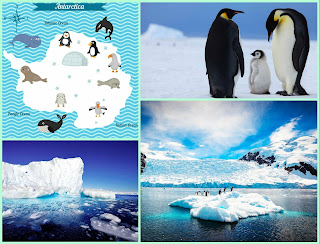Green Antarctica
Exploring Antarctica
#Green Antarctica
Just listening to the word Antarctica, the first and foremost picture that strikes in our mind is of a place which is covered with white sheets of glaciers, giant icebergs and chunks of white snow wrapped stretch of land with the cutest Penguins roaming all around.
But, with a great grief
and disappointment, “SJ Ideas” would like to convey a message to all our
beloved readers that the picture is no more the same in reality. So, have
patience and go through the blog to know in details about “Green Antarctica”
Land
Antarctica
Antarctica is the
Southernmost Continent of Earth situated at the South Pole of the Globe in the
Antarctic Region. Antarctica is the coldest, driest, windiest and the fifth
largest continent with nearly twice the size of Australia. About 98% of the
landmass is covered with ice and it is a Polar Desert as there has been no
precipitation for almost 2million years. The whole continent is divided into
two regions – East & West Antarctica. East Antarctica covers around two-
thirds of the total area with an approximately 2km thickness ice. While West
Antarctica comprises of a series of frozen islands forming an extension of
Andes Mountains.
Climate
Antarctica has the world record of lowest temperature ranging
from -89.2°C near inland to -60°C at sea level which was measured at Vostok Station,
Russia on July 21, 1983. Temperatures usually vary from place to place in the
Antarctica Continent. The mean temperature during coldest Months ranges from -20
to -30°C on the Coast & -40 to -70°C in the interior whereas in
mid-summer the temp is approximately 15°C in the Antarctic Peninsula, mean
temp of 0°C on the coast & -20 to -30°C in the interior.
Life Forms
Only a few life forms
could adapt & survive in the extreme cold climate, high speed winds and
aridity all throughout the year.
Plant Life
Out of total 800 species
of plants reported in Antarctica, 350 are lichens. These Lichens are capable to
withstand extreme weather conditions & high stress periods by remaining in
dormant forms. Beside these, Mosses & Liverworts account for 100 species.
Certain Blue Green Algae, Diatoms & Phytoplankton are also found near the coast.
Certain fungi and bacteria
also survive in the arid climate of Antarctica.
Animal Life
The native land fauna
mostly comprises of Invertebrates that includes heliozoans, rotifers,
tardigrades, nematodes ,ciliate protozoa & arthropods.
Out of the total 45
species of Birds found in the South of Antarctic convergence, only 3 breeds –
Emperor Penguin, Antarctic Petrel & South Polar Skuas are exclusively found
on the continent and along costal lines . Penguins are the sole life form that
symbolically represent the Icy Antarctica.
The sea and the coastal
areas inhabit a variety of Zooplanktons, Crustacea, Mollusc, Whales, Seals,
Dolphins.
All these life forms comprise of the Antarctica’s vivid
ecosystem & enrich the biodiversity.
Green Antarctica
Here the word ‘green’
symbolizes mainly widespread and rapid Algal growth and Mosses that are
covering up the White & Icy Antarctic Peninsula mainly near the islands on
western coast.
The Main Etiology behind Green Antarctica
With global climatic
changes, green house effects and ultimately Global Warming paves the way to
changing ecosystem, habitat destruction, loss of nature’s equilibrium & Biodiversity.
The rising temp is mainly
responsible for melting of ice at a much faster rate than usual and warmer
temperature of water above melting point is highly suitable and perfect for the
growth of algae and mosses.
On 9th Feb,
2020, Brazilian Scientists have recorded 20.75 °C temp which is the highest and maximum
temp reported for the first time at Seymour’s Island near the Antarctic Peninsula’s
northern tip. Just before 3 days to this, Argentina’s Research Station located
at Peninsula itself recorded 18.30°C
of the mainland.
This is really an alarming
scenario and a matter of great concern for all of us.
Recent Scientific Study Reports
A team of researchers at
the University of Cambridge & the British Antarctic Survey have created the
first large scale map of the green algae using European Space Agency’s Sentinel 2 Satellite
data, remote sensing& fieldwork observations during the year 2017- 2019.
These Scientists believe that in near future these algal blooms are going to
expand their range because of the global heating conditions.
Matt Davey, one of the
research Scientist of Cambridge University who was leading this survey reported
that these algae have formed close relationship with certain groups of fungi
and bacteria . Thus, togetherly they are capable to generate new habitats and
form a new ecosystem.
According to the reports
published in the Journal Nature Communications, green algae although
microscopic but when they are growing at a large scale appears as green patches
blanketing the crystal white snow as captured from the space.
The 6 years of exhaustive
and elaborate study and detailed survey by the joint effort of all the research
scientists identified 1679 separate blooms of green snow algae. They found the
largest bloom covering an area of approximately 1,45,000 m2 (almost 36 acre) on
Robert Island on the South Shetland Islands
The total area covered by the Green Snow algae was 1.9 km2 as compared to total vegetation area in the peninsula that accounts for 8.5km2.
Over 60% of Algal Blooms
were found near Penguin colonies and Bird’s resting sites as their excrement
worked as good fertilizers for algal growth.
Another interesting fact
is the huge carbon sink generated due to this algal blooms as algae utilizes the atmospheric CO2 during
the process of photosynthesis. The researchers estimated that those observed
algae removed 479tons of atmospheric CO2 per year. This data equates to an
average of 8,75,000 car journeys in UK or
486 Flights between London & New York.
In another Study,
researchers told that they isolated moss bank cores dating back to 150 years
from three sites across the Peninsula and since 1950 the moss growth and their
accumulation have increased markedly due to continuous rise in global
temperature and climatic changes.
Impact
With Algal bloom slowly & slowly over years, there will be habitat change and a day will come in future when we will witness a complete transformation of Antarctica’s landforms where there will be no more Snow capped Antarctica instead a green plain land.
Those green algae and
certain red and orange pigments producing algae stain the snow and will darken
the land over years.
The temp of the continent’s
land is increasing due to Global warming and thus the ice are melting down,
huge glaciers are splitting up into small pieces, all of these contribute to
increase in the water level of the ocean and sea. This may give rise to floods
in other places and lead to huge destruction and devastations.
There is a potential
threat to the life of terrestrial as well as aquatic flora & fauna. Many
valuable species of Antarctica continent may get endanger or some may become
extinct in near future. This will hamper the rich biodiversity of our globe.
The food chains & food
webs will be disturbed and this may lead to a serious impact on Nature.
There will be a complete reversal of the existing Ecosystem at Antarctica with the increasing green algae growth and as we all know that everything in nature is so much interconnected & interwoven that a little change with its cumulative effect is going to bring a huge outburst in future, about which we are completely unaware and we literally don’t have any idea how Nature is going to show it’s power.
So, it’s high time to
spread awareness among people across the Globe so that we human beings can
check our activities which are contributing to the burning issue of Global
Warming.
Raise the Slogan
“Stop Global Warming
&
Save Antarctica from turning Green”
Antarctica’s rich
biodiversity with a mesmerizing & eye catching varieties of Whales, Dolphins, Seals,
Penguins and colourful and vibrant
migratory birds are really wonders of our Mother Earth. So, let us all
take a pledge to protect them as far as possible by our small initial steps and
prevent man- made Global Warming.
Antarctica is so beautiful in ‘White’, Penguins love to play in Snow & Dolphins love to dive in icy cool water. So, let them enjoy their habitat without making it ‘Green’.
Take Care & Stay Safe.
Love from “SJ Ideas”
If you like it, please let us know in the comment section.
Follow us by Clicking the 3 bar lines at the left most corner of our Blog Main Page and click on "Follow" button.
Stay tuned and follow us for our Next Blog…









Great ... Much informative..👍
ReplyDeleteKhub sundor.. waiting for more ��
ReplyDelete